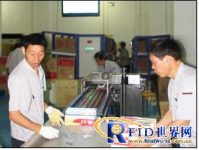
Tobacco warehouse system solution based on RFID technology
[ad_1]

project description:
Tobacco is a fast-moving consumer product and belongs to a fast-moving industry. Various tobacco companies are competing fiercely and rushing to occupy terminal stores. The speed of circulation is the most important factor in the market competition, and the management of the warehouse is the most direct factor that determines the speed of circulation. Tobacco warehouse system solutions based on RFID technology are mainly for small and medium-sized enterprises to solve the problems of manual sorting confusion, slow inventory speed, small storage area, etc., and various operations such as warehouse arrival inspection, warehousing, outgoing, inventory counting, and query The data is automatically collected.
Tobacco warehouse system solution based on RFID technology
Tobacco warehouse system solution based on RFID technology uses RFID technology to automatically collect data from the warehouse’s arrival inspection, warehousing, outgoing, inventory counting, query and other operations to ensure the speed of data input in all aspects of warehouse management And accuracy, to ensure that the company can timely and accurately grasp the real data of the inventory, and reasonably maintain and control the company’s inventory.
1. Storage
A fixed reader is placed at the door of the warehouse, and after receiving the warehousing order, the products with RFID electronic tags are put into the warehouse according to the rules. When a product with an RFID electronic tag enters the electromagnetic wave range of the fixed reader, it will automatically activate and communicate with the fixed reader to collect RFID tags. After completion, compare it with the tobacco order and check the goods information.
2. Delivery
When leaving the warehouse, push the goods to the door of the warehouse, and use the fixed reader to communicate with the goods with electronic tags to collect the RFID electronic tags of the goods out of the warehouse. After completion, check with the tobacco outgoing list to check the goods information .
3. Inventory
After the inventory plan is in place, the handheld RFID terminal is used to carry out inventory scans, inventory information of tobacco, and pass it to the back-end database through the wireless network, compare it with the information in the database, and generate difference information that is displayed on the RFID handheld terminal in real time to provide inventory The staff checked and finally completed the inventory.
4. Query statistics
Warehouse management personnel can perform query and statistical operations on the information in the system database, query the situation of a single or a batch of goods, and query and fuzzy query according to any field set. The staff can clearly understand the unit, specification, name, storage situation, transfer history, statistics of various types of goods, effective goods information, etc. through the system.
5. Interface and data interaction with other systems
The RFID tobacco warehouse system reserves the company’s other own management system interfaces, such as the company’s ERP system, financial data system, etc. Through the company’s system interface, it can be seamlessly connected, supports data import and information exchange, and can be managed with other company’s own management systems. The system directly performs batch data exchange processing.
Hardware modules based on RFID technology
1. Electronic label
Passive electronic tagsRFIDThere are two types of electronic tags and active RFID electronic tags. Passive RFID electronic tags do not have a built-in battery. When outside the reading range of the reader, the RFID electronic tag is in a passive state and cannot actively communicate with the reader; when it is within the reading range of the reader, the RFID electronic tag is The radio frequency energy emitted by the reader extracts the power required for its work and communicates with the reader. The energy of the active RFID electronic tag is provided by the battery, has a long reading distance, and can actively send signals to communicate with the reader.
2. RFID Reader
RFID readers include handheld RFID readers and fixed readers. The principle is to carry out wireless communication with the RFID electronic tag through the antenna to realize the reading and writing operation of the tag identification code and memory data. Fixed readers are generally installed at the door of the warehouse; handheld RFID readers can move in the warehouse, can receive signals from active electronic tags in real time, and transfer the received data to the background management system.
3. Antenna
Reader antennas generally require the use of directional antennas, which can be divided into two types: combined and separate. Multi-assembly means that the antenna and the chip are integrated together, while sub-assembly means that the antenna and the chip are connected through a coaxial line. Generally speaking, the design requirements of the reader antenna are lower than that of the tag antenna.
[ad_2]


